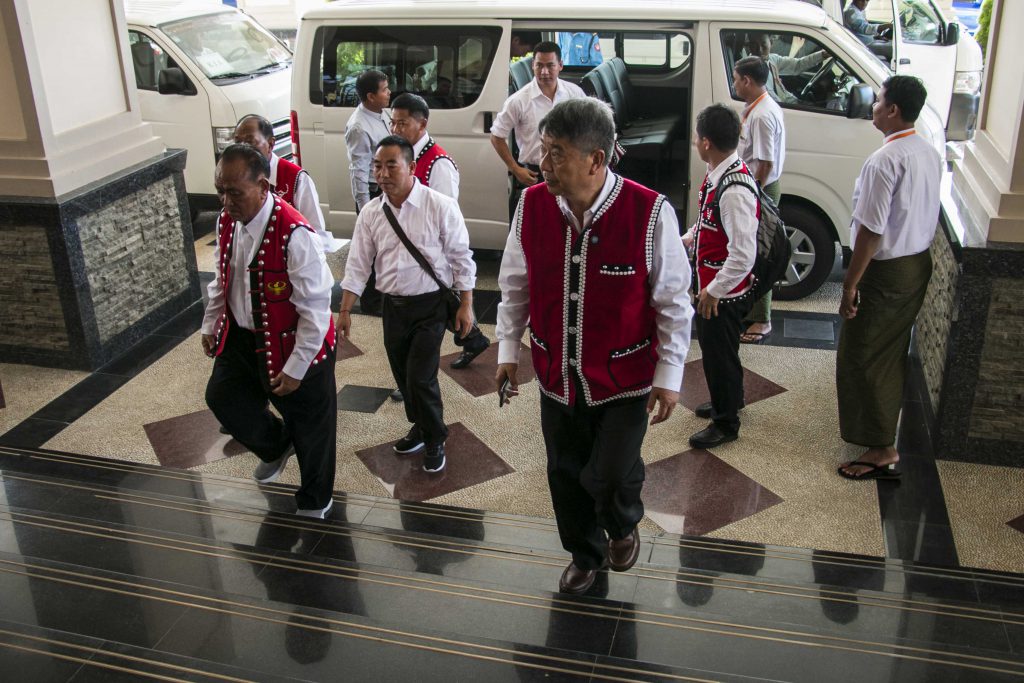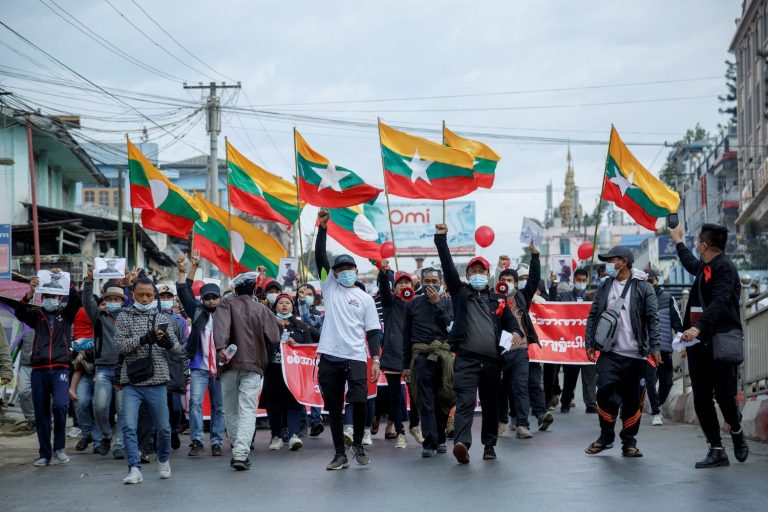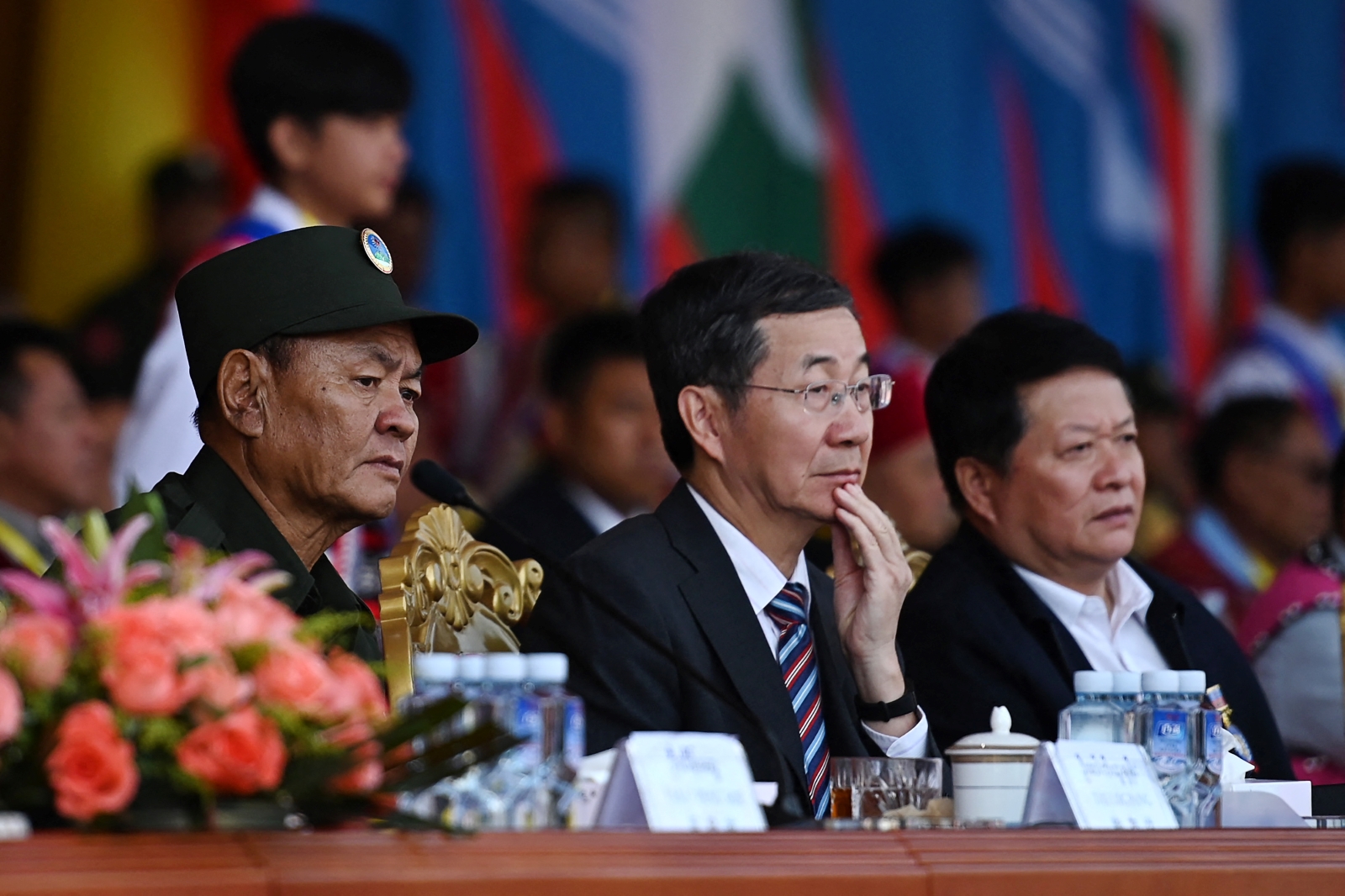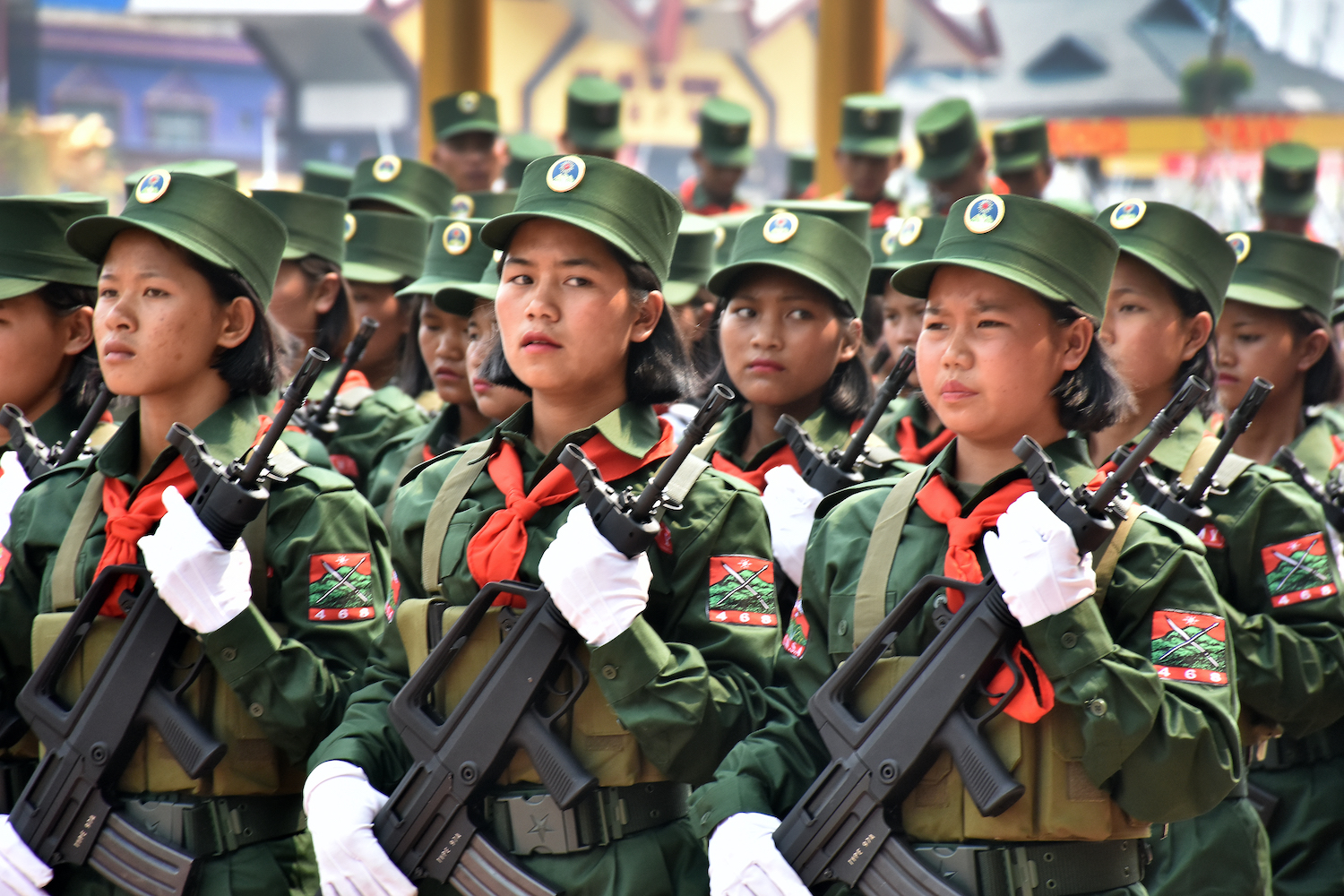A big challenge facing the FPNCC is that its participation in the peace process will require a change of mind by the government and the Tatmadaw.
By JOE KUMBUN | FRONTIER
THE SEVEN members of the Northern Alliance met at the headquarters of the United Wa State Army in Panghsang in August for a meeting that has important implications for the peace process.
A statement released on August 24 said the gathering, attended by 28 representatives of the seven ethnic armed groups, agreed on executive positions for the Federal Political Negotiation and Consultative Committee, the political negotiation team unveiled by the alliance after a meeting in Panghsang in April.
U Bao Youxiang, the leader of the UWSA, was named FPNCC chairman, with General N’Ban La, the deputy leader of the Kachin Independence Organization – and a former chairman of another coalition of ethnic armed groups, the United Nationalities Federal Council – was named deputy chair. Senior members of other groups were named to secretarial and other positions. The meeting also drafted a framework, written in Myanmar and Chinese, for future dialogue with the government.
As well as the UWSA and the KIO, the Northern Alliance comprises the National Democratic Alliance Army (also known as the Mongla group), the Myanmar National Democratic Alliance Army (also known as the Kokang group), the Shan State Progress Party/Shan State Army-North, the Ta’ang National Liberation Army, and the Arakan Army.
The meeting included talks with a delegation from the UNFC, led by Nai Han Thar of the New Mon State Party, on a potential tie-up between the two blocs to expedite political talks with the government. The talks focused on a common vision for establishing a federal democratic Myanmar.
A lingering question since the FPNCC was formed has been whether it will succeed in achieving its objectives. It is too early to give an answer. However, it is worth noting that while there are some differences among the seven members of the Northern Alliance over the peace process, they share the same political goal: a peaceful, harmonious Myanmar.
Five members of the alliance have been the targets of offensives launched by the Tatmadaw, with the UWSA and NDAA remaining aloof from the fighting.
What the UWSA wants
The UWSA is the largest ethnic armed group, with up to 30,000 active military personnel, and it has strengthened its importance in the alliance by taking the chairmanship of the FPNCC. The UWSA’s interest in the peace process can be described as two-fold.
The UWSA’s main goal is to have the territory under its control recognised as a state within Myanmar, a status it has claimed since the tenure of former president U Thein Sein. The United Wa State Party administers six townships known as Shan State (North) Special Region-2, which under the 2008 Constitution is called the Wa Self-Administered Division. On January 1, 2009, the UWSA unilaterally named the territory under its control the Wa State Government Special Administrative Region.
The UWSA’s second objective is to demonstrate, within Myanmar and internationally, its willingness to achieve peace and be involved in the peace process. It has calculated that involvement in a process aimed at achieving lasting peace in Myanmar will help it to achieve legitimacy domestically and internationally.
dsc_6688.jpg
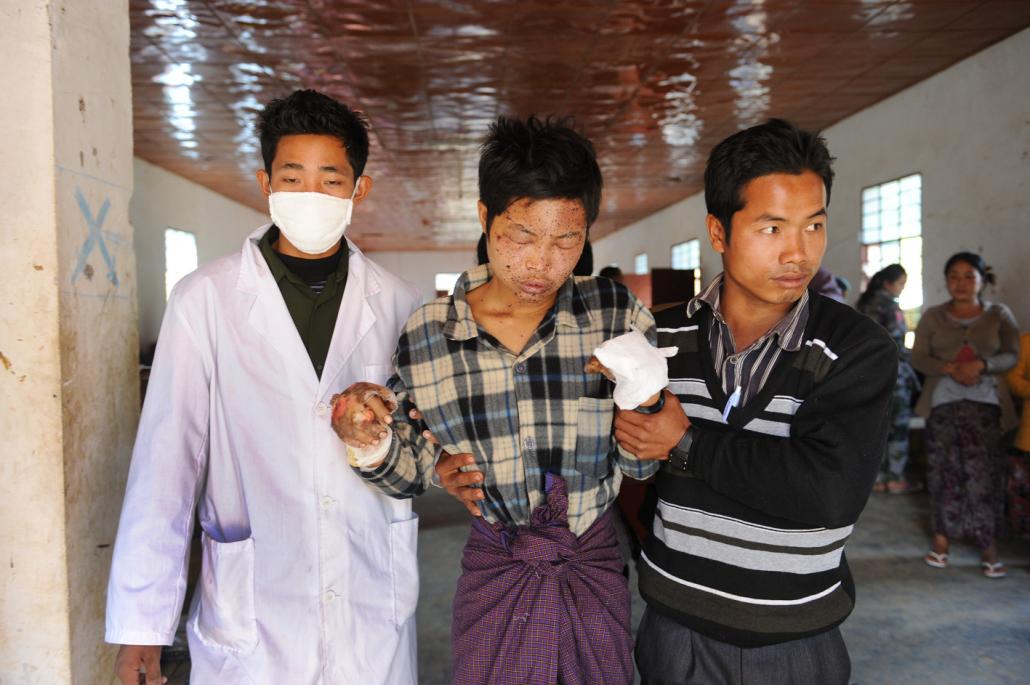
title=
In fact, the UWSA has de facto independence from Myanmar. In September 2011 it became the first ethnic armed group to sign a ceasefire with the Thein Sein government. It had previously signed a ceasefire with the junta in May 1989. The UWSA is unlikely to provoke the Tatmadaw or to take a bellicose stand towards the peace process.
The Tatmadaw will not drag the UWSA into the conflict; it is stretched enough grappling with other groups.
Another reason for the UWSA’s desire to avoid conflict may be the businesses it owns directly or indirectly. In an October 2015 report, watchdog organization Global Witness said the UWSA was a major player in the illegal jade trade through U Wei Hsueh Kang, whom it described as a narcotics kingpin and long-time financier of the UWSA. Wei Hsueh Kang and his associates are said to have used a web of opaque companies to build and disguise a jade empire that was tolerated by the former military régime.
What the KIO wants
The KIO came under strong criticism from many Kachin over its decision to pull out of the UNFC. Many also questioned its decision to join the USWA-led Northern Alliance. The KIO’s armed wing, the Kachin Independence Army, has come under heavy pressure from the Tatmadaw since a bilateral ceasefire collapsed in June 2011, and has since lost several strategic outposts. The fighting has displaced tens of thousands of civilians, and the KIO is keen to end the conflict and accelerate the momentum of the peace process to create the Federal Union to which the Kachin have long aspired.
The KIO has also sought to have representatives from foreign countries, particularly the United States, involved in the peace process. On November 9, 2013, the KIA’s Major-General Gun Maw held talks at the US embassy in Yangon with then-ambassador Mr Derek Mitchell. Gun Maw reportedly sought an avenue for US involvement in the peace talks. In April 2014, Gun Maw travelled to the US on a visit that included talks with senior State Department officers and officials at the United Nations.
uwsa_soldiers.jpg
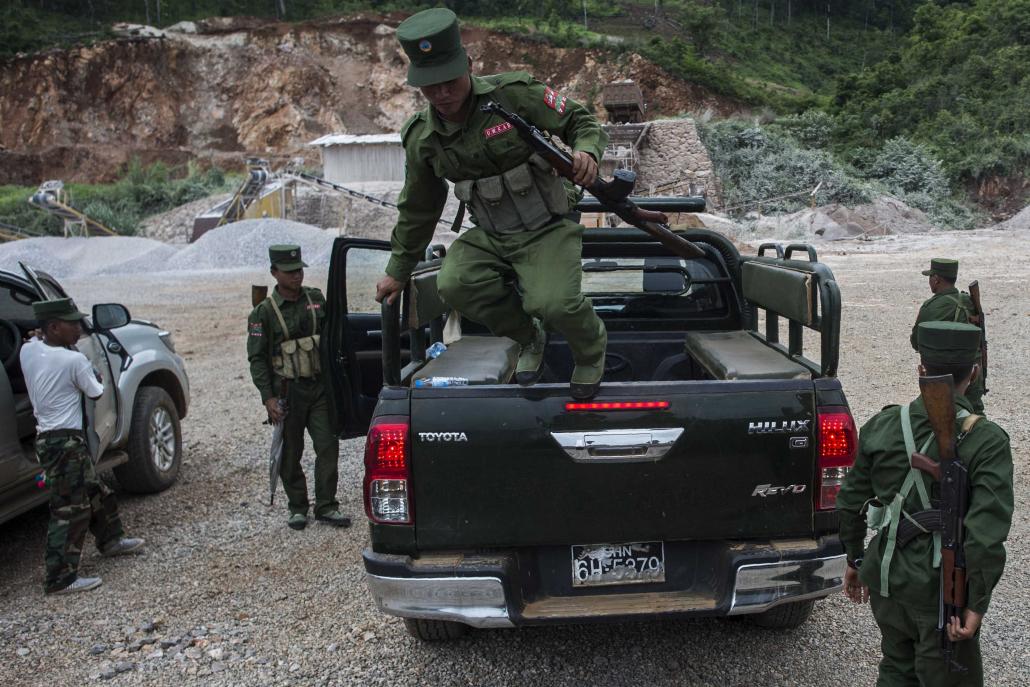
title=
Unlike the UWSA, the KIO has historically rejected the ideology of the Chinese Communist Party. This is the main reason why the KIO has not received major support from Beijing. However, there is prima facie evidence that the UWSA has received modern weaponry from China, including tanks, helicopters, 105mm mortars, sniper rifles, and anti-tank weapons.
The Northern Alliance said in its August 24 statement that it would welcome China’s involvement in the peace process, whereas the KIO would prefer Western countries to be involved.
What the other armed groups want
The other members of the Northern Alliance – the AA, MNDAA, TNLA, SSPP and NDAA – need to be part of a strong group for their survival.
The AA and the TNLA need more outside support, particularly from the UWSA, which has reportedly provided military equipment to smaller ethnic armed organisations. It is worth noting that the AA and TNLA became members of the Wa-led alliance before the KIO joined.
The other three groups – MNDAA, NDAA, and SSPP – have geographic links with the UWSA. The Kokang and Mongla groups have also had a long and strong relationship.
These five groups can be expected to closely follow the position taken by the USWA on the peace process.
What’s next?
Following the appointment of an executive for the FPNCC and the drafting of a framework for political dialogue, the Northern Alliance is looking forward to talks with the government and the Tatmadaw.
In the August 24 statement, the alliance emphasised adherence to its policy that any political negotiations with the government and the Tatmadaw involve the FPNCC as a bloc, rather than separate talks with the seven groups.
However, the government and the Tatmadaw do not want to negotiate with the FPNCC collectively. The government has been seeking separate talks with the seven groups. It has been reported that the government wants to send a delegation headed by the vice chair of its Peace Commission, U Thein Zaw, to Panghsang for talks with the UWSA leadership. That trip may take place in September.
Returning to the question about whether the FPNCC can effectively represent the interests of its members, that will depend on its structure, ability to set common goals and vision. An important issue will be how much space the FPNCC allows for contributions from civil society groups and intellectuals.
The FPNCC will be effective if all its members stand shoulder-to-shoulder to protect one another. This would mean the adoption by its members of a policy under which they would agree to provide military support for each other if one of them came under attack.


